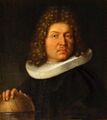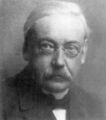Template:Selected anniversaries/August 16: Difference between revisions
No edit summary |
No edit summary |
||
| Line 1: | Line 1: | ||
<gallery> | <gallery> | ||
File:Vincenzo Coronelli.jpg|link=Vincenzo Coronelli (nonfiction)|1650: Monk, cosmographer, and cartographer [[Vincenzo Coronelli (nonfiction)|Vincenzo Coronelli]] born. He will gain fame for his atlases and globes; some of the globes will be very large and highly detailed. | File:Vincenzo Coronelli.jpg|link=Vincenzo Coronelli (nonfiction)|1650: Monk, cosmographer, and cartographer [[Vincenzo Coronelli (nonfiction)|Vincenzo Coronelli]] born. He will gain fame for his atlases and globes; some of the globes will be very large and highly detailed. | ||
| Line 8: | Line 6: | ||
File:Jacob Bernoulli.jpg|link=Jacob Bernoulli (nonfiction)|1705: Mathematician [[Jacob Bernoulli (nonfiction)|Jacob Bernoulli]] dies. He discovered the fundamental mathematical constant ''e'', and made important contributions to the field of probability. | File:Jacob Bernoulli.jpg|link=Jacob Bernoulli (nonfiction)|1705: Mathematician [[Jacob Bernoulli (nonfiction)|Jacob Bernoulli]] dies. He discovered the fundamental mathematical constant ''e'', and made important contributions to the field of probability. | ||
||Đuro Kurepa | ||1907: Đuro Kurepa born ... mathematician. Pic. | ||
||1744 | ||1744: Pierre Méchain born ... astronomer and surveyor. | ||
File:Arthur Cayley.jpg|link=Arthur Cayley (nonfiction)|1821: Mathematician and academic [[Arthur Cayley (nonfiction)|Arthur Cayley]] born. He will be the first to define the concept of a group in the modern way, as a set with a binary operation satisfying certain laws. | File:Arthur Cayley.jpg|link=Arthur Cayley (nonfiction)|1821: Mathematician and academic [[Arthur Cayley (nonfiction)|Arthur Cayley]] born. He will be the first to define the concept of a group in the modern way, as a set with a binary operation satisfying certain laws. | ||
||Wilhelm Maximilian Wundt | ||1832: Wilhelm Maximilian Wundt born ... physician, physiologist, philosopher, and professor, known today as one of the founding figures of modern psychology. Wundt, who noted psychology as a science apart from philosophy and biology, was the first person ever to call himself a psychologist. He is widely regarded as the "father of experimental psychology." Pic. | ||
||1836 | ||1836: Marc-Antoine Parseval dies ... mathematician and theorist. | ||
||1842 | ||1842: Jakob Rosanes born ... mathematician, chess player, and academic. | ||
||1845 | ||1845: Gabriel Lippmann born ... physicist and academic, Nobel Prize laureate. | ||
||Johan Gustav Christoffer Thorsager Kjeldahl born ... chemist who developed a method for determining the amount of nitrogen in certain organic compounds using a laboratory technique which was named the Kjeldahl method after him. Pic. | ||1849: Johan Gustav Christoffer Thorsager Kjeldahl born ... chemist who developed a method for determining the amount of nitrogen in certain organic compounds using a laboratory technique which was named the Kjeldahl method after him. Pic. | ||
||Johann Heinrich Graf | ||1852: Johann Heinrich Graf born ... mathematician who was rector of the University of Bern and promoter of the Swiss National Library. Pic. | ||
||1858 | ||1858: U.S. President James Buchanan inaugurates the new transatlantic telegraph cable by exchanging greetings with Queen Victoria of the United Kingdom. However, a weak signal forces a shutdown of the service in a few weeks. | ||
||1863: Frederic Stanley Kipping born ... chemist. He undertook much of the pioneering work on silicon polymers and coined the term silicone. Pic not Wikipedia: https://www.google.com/search?q=frederick+kipping&rlz=1C1CHBF_enUS702US702&oq=Frederick+Kipping&aqs=chrome.0.0j69i60j69i61j0l2.527j0j7&sourceid=chrome&ie=UTF-8 | ||1863: Frederic Stanley Kipping born ... chemist. He undertook much of the pioneering work on silicon polymers and coined the term silicone. Pic not Wikipedia: https://www.google.com/search?q=frederick+kipping&rlz=1C1CHBF_enUS702US702&oq=Frederick+Kipping&aqs=chrome.0.0j69i60j69i61j0l2.527j0j7&sourceid=chrome&ie=UTF-8 | ||
| Line 32: | Line 30: | ||
||1867: Ronald Montagu Burrows born ... English archaeologist who in 1895-96 conducted excavations in southwestern Greece at Pylos and the adjacent island of Sphacteria, revealing remains of Spartan fortifications. These confirmed the battle of 425 BC in the Peloponnesian War recorded by the ancient Athenian historian Thucydides. Burrows was by nature a classicist, whose primary purpose in seeking tangible evidence from the past was to verify ancient texts. At Rhitsona, in Boeotia (1905, 1907), his original goal was to find the temple of Delium, but without success. Instead he found and catalogued artifacts from Boeotian graves dating from the 7th and 6th century B.C. at the necropolis of Mykalessos, near Tanagra. In 1907, he published Recent Discoveries in Crete. | ||1867: Ronald Montagu Burrows born ... English archaeologist who in 1895-96 conducted excavations in southwestern Greece at Pylos and the adjacent island of Sphacteria, revealing remains of Spartan fortifications. These confirmed the battle of 425 BC in the Peloponnesian War recorded by the ancient Athenian historian Thucydides. Burrows was by nature a classicist, whose primary purpose in seeking tangible evidence from the past was to verify ancient texts. At Rhitsona, in Boeotia (1905, 1907), his original goal was to find the temple of Delium, but without success. Instead he found and catalogued artifacts from Boeotian graves dating from the 7th and 6th century B.C. at the necropolis of Mykalessos, near Tanagra. In 1907, he published Recent Discoveries in Crete. | ||
||Gerhard Hessenberg | ||1874: Gerhard Hessenberg ... mathematician. He received his Ph.D. from the University of Berlin in 1899 under the guidance of Hermann Schwarz and Lazarus Fuchs. His name is usually associated with projective geometry, where he is known for proving that Desargues' theorem is a consequence of Pappus's hexagon theorem, and differential geometry where he is known for introducing the concept of a connection. | ||
||1884: Hugo Gernsback born ... inventor, writer, editor, and magazine publisher, best known for publications including the first science fiction magazine. Pic. | ||1884: Hugo Gernsback born ... inventor, writer, editor, and magazine publisher, best known for publications including the first science fiction magazine. Pic. | ||
||1886 | ||1886: Sri Ramakrishna Paramahamsa dies ... mystic and philosopher. | ||
||1888 | ||1888: John Pemberton dies ... pharmacist and chemist, invented Coca-Cola. | ||
||1892 | ||1892: Otto Messmer born ... cartoonist and animator, co-created Felix the Cat. | ||
||1893 | ||1893: Jean-Martin Charcot dies ... French neurologist and academic. | ||
||Boris Mikhailovich Hessen | ||1893: Boris Mikhailovich Hessen ... physicist, philosopher and historian of science. He is most famous for his paper on Newton's Principia which became foundational in historiography of science. | ||
File:Erik Ivar Fredholm.jpg|link=Erik Ivar Fredholm (nonfiction)|1898: Mathematician and crime fighter [[Erik Ivar Fredholm (nonfiction)|Erik Ivar Fredholm]] publishes new class of integral equations which anticipate the use of Hilbert spaces in [[high-energy literature]]. | File:Erik Ivar Fredholm.jpg|link=Erik Ivar Fredholm (nonfiction)|1898: Mathematician and crime fighter [[Erik Ivar Fredholm (nonfiction)|Erik Ivar Fredholm]] publishes new class of integral equations which anticipate the use of Hilbert spaces in [[high-energy literature]]. | ||
| Line 50: | Line 48: | ||
File:Robert Bunsen.jpg|link=Robert Bunsen (nonfiction)|1899: Chemist and academic [[Robert Bunsen (nonfiction)|Robert Bunsen]] dies. He investigated emission spectra of heated elements, and discovered caesium (in 1860) and rubidium (in 1861) with the physicist Gustav Kirchhoff. | File:Robert Bunsen.jpg|link=Robert Bunsen (nonfiction)|1899: Chemist and academic [[Robert Bunsen (nonfiction)|Robert Bunsen]] dies. He investigated emission spectra of heated elements, and discovered caesium (in 1860) and rubidium (in 1861) with the physicist Gustav Kirchhoff. | ||
||1927 | ||1927: The Dole Air Race begins from Oakland, California, to Honolulu, Hawaii, during which six out of the eight participating planes crash or disappear. | ||
||1904 | ||1904: Wendell Meredith Stanley born ... biochemist and virologist, Nobel Prize laureate. | ||
||Marian Adam Rejewski | ||1905: Marian Adam Rejewski born ... mathematician and cryptologist who reconstructed the Nazi German military Enigma cipher machine sight-unseen in 1932. The cryptologic achievements of Rejewski and colleagues Jerzy Różycki and Henryk Zygalski enabled the British to begin reading German Enigma-encrypted messages at the start of World War II. Pic. | ||
||Paul Olum | ||1918: Paul Olum born ... mathematician (algebraic topology), professor of mathematics, and university administrator. Pic. | ||
||Sir Joseph Norman Lockyer | ||1920: Sir Joseph Norman Lockyer dies ... scientist and astronomer. Along with the French scientist Pierre Janssen he is credited with discovering the gas helium. Lockyer also is remembered for being the founder and first editor of the influential journal Nature. Pic. | ||
||1920 | ||1920: Charles Bukowski born ... poet, novelist, and short story writer. | ||
||1930 | ||1930: The first color sound cartoon, called Fiddlesticks, is made by Ub Iwerks. | ||
||1942 | ||1942: World War II: The two-person crew of the U.S. naval blimp L-8 disappears without a trace on a routine anti-submarine patrol over the Pacific Ocean. The blimp drifts without her crew and crash-lands in Daly City, California. | ||
||1957 | ||1957: Irving Langmuir dies ... chemist and physicist, Nobel Prize laureate. | ||
||1966 | ||1966: Vietnam War: The House Un-American Activities Committee begins investigations of Americans who have aided the Viet Cong. The committee intends to introduce legislation making these activities illegal. Anti-war demonstrators disrupt the meeting and 50 people are arrested. | ||
||1973 | ||1973: Selman Waksman dies ... biochemist and microbiologist, Nobel Prize laureate. | ||
||1989 | ||1989: A solar flare from the Sun creates a geomagnetic storm that affects micro chips, leading to a halt of all trading on Toronto's stock market. | ||
||Thomas Brooke Benjamin | ||1995: Thomas Brooke Benjamin dies ... mathematical physicist and mathematician, best known for his work in mathematical analysis and fluid mechanics, especially in applications of nonlinear differential equations. Pic. | ||
||2013 | ||2013: David Rees dies ... mathematician and academic. | ||
File:Ultravore.jpg|link=Ultravore|2017: Researchers publish new evidence that "suicide-by-[[Ultravore]]" is on the rise. | File:Ultravore.jpg|link=Ultravore|2017: Researchers publish new evidence that "suicide-by-[[Ultravore]]" is on the rise. | ||
||2015 | ||2015: Jacob Bekenstein dies ... theoretical physicist, astronomer, and academic ... made fundamental contributions to the foundation of black hole thermodynamics and to other aspects of the connections between information and gravitation. | ||
|File:Exponential-growth-diagram.svg|link=Crimes against mathematical constants|2016: New class of [[Crimes against mathematical constants]] "reduce to well-known [[Crime (nonfiction)|crime]] algorithms." | |File:Exponential-growth-diagram.svg|link=Crimes against mathematical constants|2016: New class of [[Crimes against mathematical constants]] "reduce to well-known [[Crime (nonfiction)|crime]] algorithms." | ||
</gallery> | </gallery> | ||
Revision as of 19:50, 14 August 2018
1650: Monk, cosmographer, and cartographer Vincenzo Coronelli born. He will gain fame for his atlases and globes; some of the globes will be very large and highly detailed.
1694: Mathematician, astronomer, and crime-fighter Christiaan Huygens reveals in autobiography that he uses statistical analysis and games of chance to catch math criminals in the act.
1705: Mathematician Jacob Bernoulli dies. He discovered the fundamental mathematical constant e, and made important contributions to the field of probability.
1821: Mathematician and academic Arthur Cayley born. He will be the first to define the concept of a group in the modern way, as a set with a binary operation satisfying certain laws.
1898: Mathematician and crime fighter Erik Ivar Fredholm publishes new class of integral equations which anticipate the use of Hilbert spaces in high-energy literature.
1899: Chemist and academic Robert Bunsen dies. He investigated emission spectra of heated elements, and discovered caesium (in 1860) and rubidium (in 1861) with the physicist Gustav Kirchhoff.
2017: Researchers publish new evidence that "suicide-by-Ultravore" is on the rise.






